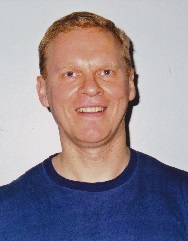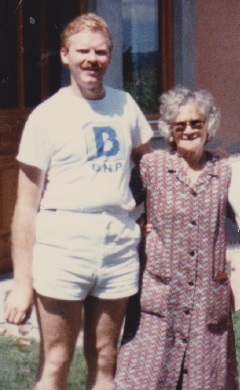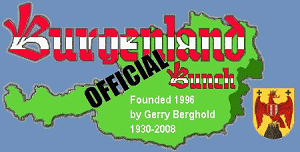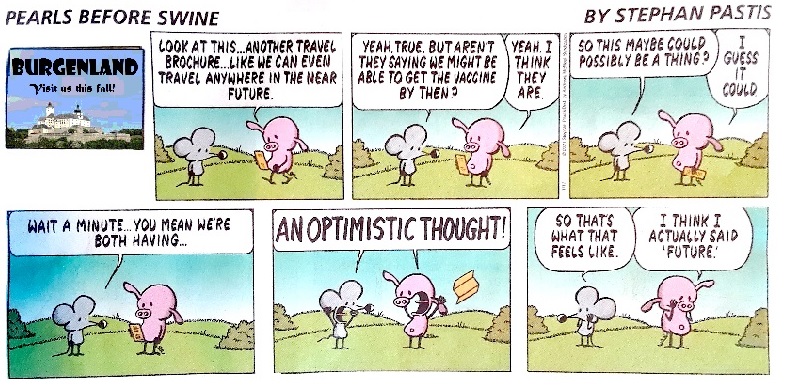|
The
|
||||||||||||
THE BURGENLAND BUNCH NEWS - No. 316 January 31, 2021, © 2021 by The Burgenland Bunch All rights reserved. Permission to copy excerpts granted if credit is provided. Editor: Thomas Steichen (email: tj.steichen@comcast.net) BB Home Page: the-burgenland-bunch.org BB Newsletter Archives: BB Newsletter BB Facebook Page: TheBurgenlandBunchOFFICIAL Our 25th year! The Burgenland Bunch Newsletter is issued monthly online. The BB was founded in 1997 by Gerald Berghold, who died in August 2008. |
||||||||||||
| Current Status Of The BB: * Members: 3013 * Surname Entries: 8893 * Query Board Entries: 5849 * Staff Members: 13 |
||||||||||||
This newsletter concerns: 1) THE PRESIDENT'S CORNER 2) AN AMERICAN’S FIRST TIME IN BURGENLAND, Part II (by John Lostys) 3) HISTORICAL BB NEWSLETTER ARTICLES: - A NAME IS A NAME, RIGHT? 4) ETHNIC EVENTS 5) BURGENLAND EMIGRANT OBITUARIES (courtesy of Bob Strauch) |
||||||||||||
1) THE PRESIDENT'S CORNER (by Tom Steichen)  Still
wearing my mask... hope you are too! I'm also pleased to note that I'm scheduled for my first Covid
vaccine shot on February 3rd (being I'm an old dude!), so my personal light at the end of this bleak coronavirus tunnel is
getting brighter. Let's hope it is effective against the new variants too! [With this thought in mind, I gave you a bonus
slightly-edited cartoon below... couldn't resist!] Still
wearing my mask... hope you are too! I'm also pleased to note that I'm scheduled for my first Covid
vaccine shot on February 3rd (being I'm an old dude!), so my personal light at the end of this bleak coronavirus tunnel is
getting brighter. Let's hope it is effective against the new variants too! [With this thought in mind, I gave you a bonus
slightly-edited cartoon below... couldn't resist!]My first bit of business is to congratulate Burgenland on attaining 100 years as a part of Austria: Congratulations! As you will see below, I do that more formally in an article I wrote for the BG Newsletter. Also, if you haven't seen it yet, you should watch the YouTube video Happy Birthday Burgenland, which first aired on PBS on New Year's Day [note: the original link has been blocked; this link is to the full New Year's concert but is set to begin at the start of the Burgenland section]. Along with that, I will note that this is the BB's 25th year of existence, so we have a little anniversary to celebrate too. Further our member count went over 3,000 this month and our surname count approaches 9,000. Likewise, our BH&R affiliate has a "milestone" worth noting (but I'll let Frank Paukowits tell you more about that below). This month's bits and pieces (Article 1) contains my submission to the BG newsletter concerning the "100th Burgenland Birthday," a submission by BH&R's Frank Paukowits reporting on a new "milestone" achievement, still more newly-transcribed records, a rather long bit describing the "errata" for the English-edition of Walter Dujmovits' book, The Burgenländer Emigration to America, and an "official" update on the coronavirus-altered visitation situation in Austria. I conclude with our regular tidbit features, the monthly BB Facebook report, book sales and a words-for-thought item. Article 2 is the second part of John Lostys' story of visiting Burgenland 40 years ago, entitled An American’s First Time In Burgenland. Here he finally makes contact with his grandmother's friend. The remaining articles are our standard sections: Historical Newsletter Articles, (no) Ethnic Events and Emigrant Obituaries. BG Newsletter Submission: You may not be aware of it but I write a short column every quarter for inclusion in the Burgenland Gemeinschaft newsletter. The article below will appear in its next, Spring 2021, edition. “Burgenland-Bunch” (BB) www.the-burgenland-bunch.org HAPPY 100TH BIRTHDAY, BURGENLAND! To the people and government of Burgenland, congratulations from the Burgenland Bunch on your 100th Anniversary! Such magnificent change in a mere 100 years... out of the devastation of the Spanish Flu, the throes of WW-I, the dissolution of Empire, the transfer to a new country, and yet another World War and its subsequent occupation, you have forged a vital and beautiful Land, one all of your people can and should be proud of. One-hundred years ago, you were the stepchild to a new Austria, not really wanted by your sister Lands yet fought over to temper the many losses Austria had endured. You were the marginalized border region of a new Austria, crippled by the loss of your putative capital city, expected to fail by Hungary, and largely left to yourself to forge new connections between your previously unconnected parts, to establish a new government and to develop a new territorial and social identity... and you did it all! Today you are the interface between western and central Europe, a breadbasket for Vienna and a vital source of workers for its offices and businesses. You are an energy-independent destination for tourism, health and exercise. Your landscapes and villages are beautiful and thriving. Where once you were unable to support your populace, causing a massive emigration of your children to America and beyond, now your hard-earned prosperity draws immigrants to your land. As Dr. Dujmovits wrote in his book, “Once a land of emigrants, Burgenland has become a land of immigrants.” We in the Burgenland Bunch are the emigrant grandchildren of Burgenland, now a group of some 3,000 members strong, researching nearly 9,000 Burgenländisch family names and honoring in our BH&R section the foreign burial of over 25,000 of your children, children who once came to the Americas for what then was a hoped-for better life. We share in your well-deserved pride in what you have accomplished, in what you have created, and what you are. Your history is our history, your present is our joy, and your future is unlimited. Happy Birthday, Burgenland! Tom Steichen, BB President A Memorial Site for Burgenland Émigrés (by Frank Paukowits) The idea of developing
a memorial site for deceased Burgenländers who had emigrated to North America was first floated about 15 years ago. It was
envisioned that it would serve as a repository of information where émigrés could be honored and, secondly, as a resource
where BB members could use the data to research their family roots. Essentially, the plan was that the site would serve as
the equivalent of the Ellis Island site... but exclusively for Burgenländers.
— Ian MacKenzie, in the novel, Feast Days, 2018 |
||||||||||||
2) AN AMERICAN’S FIRST TIME IN BURGENLAND, Part II (by John Lostys) Editor: When we last left John, at the end of Part I of this story (see Newsletter 314), he was standing at the Mogersdorf train station in 1980, noticing lights approaching in the dark. Armed with high school German and an Interrail pass, he had made his way from Zurich to Vienna and on to Mogersdorf, leaving him, nonetheless, a few miles short of his final destination, Deutsch Minihof, the childhood home of his grandmother, Agnes Gibiser (née Pinter), and still home to her dear friend, Rosa Posch. Grandmother had told him "...so many wonderful, colorful stories of Rosa and my grandma’s times in Austria" and he was about to meet Rosa and visit the sites of their stories...  John
continues: I suddenly realized that I was not alone. The conductor had moved to the platform from behind the train and a
car with a woman inside arrived at the station. The conductor opened up the car trunk and placed my bag inside and then
opened the back door for me to get inside. John
continues: I suddenly realized that I was not alone. The conductor had moved to the platform from behind the train and a
car with a woman inside arrived at the station. The conductor opened up the car trunk and placed my bag inside and then
opened the back door for me to get inside.When I was on the train, I had asked him if he knew Rosa Posch and how to get to her house... but I gather that my high school German on the train had been pretty bad. Still, he apparently understood me—and may have said something back to me—but I did not understand the reply. High school German is very different from the local dialect. But, boy, was I relived not to be stranded in a corn field and was very happy to be riding in a very comfortable car. In less than five minutes, I was dropped off at a farm house. My grandmother had left Burgenland in 1921 and never went back. However, she always corresponded with Rosa Posch and, after the war, sent packages to her.  Now
in 1980 I opened the gate and knocked on the door. The nicest, friendliest woman, sporting a wide smile, opened the door.
Her son-in-law Rudolf and his son Kurt were vacationing with Rosa from their home in Fischamend, outside of Vienna. Rudolf
originally came from the neighboring village, Wallendorf, and moved to the Vienna area to work in a petro-chemical factory. Now
in 1980 I opened the gate and knocked on the door. The nicest, friendliest woman, sporting a wide smile, opened the door.
Her son-in-law Rudolf and his son Kurt were vacationing with Rosa from their home in Fischamend, outside of Vienna. Rudolf
originally came from the neighboring village, Wallendorf, and moved to the Vienna area to work in a petro-chemical factory.Rosa looked at me and asked me what I wanted to eat. She cooked me some eggs and salami on a wood-burning stove. With the eggs, she carved up a nice thick slice of bauernbrot with a slab of butter on it. I found out later, that the butter came from the farm across the street. The kitchen had the wonderful aroma of coffee and apfel strudel, since she had been baking that day. I had a glass of Gösser beer with the eggs. It was the first home-cooked meal I had in a while, and boy was it tasty. We started to talk, with my trusty German-English dictionary helping out at key points in the conversation. Although I had never met Rosa in person, my grandmother always spoke of her, so I soon discovered that I actually knew a lot about her. Likewise, Rosa knew a lot about me through my grandmother’s letters. Our family stories had circulated across the Atlantic, so Rosa knew my father had died when I was 17. Rosa had a wonderful son, Robert, a master painter, who died in a motorcycle accident. In fact, the cupboard in the kitchen next to where I was sitting had tiger-striping on it painted by Robert. Rosa's hand gestures, body language and accent were exactly like my grandparents’, especially when she said, “Jesus, Maria und Josef!” I felt very much at home. It was just like my grandparents’ kitchen in so many ways. After a couple of hours of friendly conversation, it was time to go to bed. Rosa turned to her grandson and said that, “He could sleep in the tent tonight, and I could get the bedroom.” Rosa’s house was one bedroom, one kitchen and two small hallways. Across the yard, was her husband's workshop. I entered the workshop, went up the stairs and there was a comfortable wooden bedroom on the second floor with a balcony overlooking fields. I slept like a puppy that night. That day was the start of a friendship that continues to this day. |
||||||||||||
3) HISTORICAL BB NEWSLETTER ARTICLES Editor: This is part of our series designed to recycle interesting articles from the BB Newsletters of past years. The entry below is an (slightly edited) extract from the longer 2011 article by that name. I'm reprinting it because the topic remains an issue in our family research work; that issue being that spelling of names was quite fluent in the Burgenland region during the era we tend to research. We must remain open to that possibility... and I think the example from this article shows how variable names could be, even just two years apart. See for yourself... THE BURGENLAND BUNCH NEWS No. 206 January 31, 2011 A NAME IS A NAME, RIGHT? BB member, Kathy Ettel Middendorf sent an email to me concerning possible changes in spelling of a surname. [She also sent...] a one-page extract from a 1999 village history of Halbturn written by Herbert Brettl (Halbturn - Im Wandel der Zeiten / "Halbturn - Through the Ages"). The page was titled "Besitzaufteilung --- 1673-1848 Wirtschaft," which translates to "Partition of Ownership --- 1673-1848 Economics." The page body was divided into two sections, with the upper section titled "Die ersten Besitzerlisten 1698" ("The first owners lists 1698"). That upper section consisted of four columns of names, with column headers as follows: 1. Ein ganzes Bauernhaus besaßen: (A whole farm owned:) 2. Ein halbes Bauernhaus gehörte: (A half farm owned:) 3. Söllnerhäuser gehörten: (Small-holder houses were:) 4. Briefhäusler waren: (Renters were: [but I could not find a good translation for this!]) The lower section was titled "72 Familien wohnen in Halbturn" (72 families live in Halbturn) and had explanatory text: "Eine Liste aus dem Jahre 1700 gibt einen hervorragenden Überblick über die Halbturner Bevölkerung und deren Besitzungem. So befanden sich in Halbturn:" (A list from 1700 gives an excellent overview of the Halbturner population and their owners. Thus were in Halbturn:). This lower section then split into two sub-tables that basically appeared to match the first two columns of the top section. To make my point [concerning name variations], I've placed the names from the first column from the top section (the owners of whole farms in 1698) in the table immediately below then "matched" the corresponding names from the lower section (i.e., the owners of whole farms in 1700).
What is interesting is that there is only a single name that matches exactly... and you must look closely
to see why I matched superficially different names as I did. I remind you that we are looking at names of farm owners (a
likely very stable group) recorded just two years apart! One might expect a little turnover... but not much... so most of
these are almost certainly the same individuals.
Here we do not find even a single name that matches exactly... many are close, but none exact. I've placed
question marks after the few that I think might be more questionable matches but, again, we see only two additional owners
of half farms and adequate match of the rest. |
||||||||||||
4) ETHNIC EVENTS (none! ...blame the virus!) LEHIGH VALLEY, PA (none) NEW BRITAIN, CT (none) ST. LOUIS, MO (none) UPPER MIDWEST (none) |
||||||||||||
5) BURGENLAND EMIGRANT OBITUARIES Louis Geosits  Allentown, Pennsylvania; December 31, 1927 - January 15, 2021 Louis Geosits lived a remarkable life. Born in Szentpéterfa (Petrovo Selo / Prostrum), Hungary, he cut through the Iron Curtain in 1951 with his brother Steve, and together they escaped in search of a better life. He traversed Austria by foot, sleeping in barns by night and scooting across logs over rivers by day until he made it to Salzburg. He spent a few pleasant years in Salzburg working in a quarry, and when he was able, boarded a ship to America. Louis landed in Allentown and enjoyed the company of many other Hungarian refugees, among whom he would meet his wife, Veronica Geosits (Krajcic). Together they had two children, William Geosits and Richard Geosits. Louis learned English, and started a successful bricklaying business, where he, his sons, and numerous employees worked for 35 years. When Veronica got sick and required advanced medical care in the early 2000’s, Louis visited her at Holy Family Manor every single day, bringing vegetables from his garden to the caretakers who worked there. Louis had many hobbies that delighted him and those who knew him; his beautiful garden, his Hungarian baking, and his newly acquired toy-making skills. These hobbies (and the occasional Busch Beer) kept Louis sharp and active until the very end. An adored brother, a devoted husband, an exemplary father, an American Small-Businessman, an inspirational Grandfather- it is impossible to remember Louis Geosits as just one thing. His practical yet daring way of life will continue to amuse and influence those who loved him. Louis is survived by his sisters, Mary Remenyi, Anna Kerese, Paula Jurasits Józsefné, his sons, William Geosits and Richard Geosits, their wives, Diane Geosits and Patricia Geosits respectively, and four grandchildren, Michelle Geosits, Laura Geosits, Holly Peck, and Nicholas Geosits. Louis never told the same story twice. His sense of humor and overwhelmingly kind disposition touched everyone lucky enough to know him. His unusual combination of whimsy and total seriousness made him captivating, and incredibly wise. Louis Geosits will be fiercely missed and dearly remembered. A graveside service will be held on Thursday, January 21st at Holy Saviour Cemetery, 2575 Linden St., Bethlehem, PA at 11:00 a.m. Arrangements are under the direction of Reichel Funeral Home, Northampton. In lieu of flowers, memorial contributions in Louis Geosits' name may be made to a charity of one’s choice. Online condolences may be offered above. Published in Morning Call on Jan. 19, 2021 Mary Keglovits (née Stubits)  Mary Keglovits, 91, formerly of
Coplay, Pennsylvania, passed away peacefully on Monday, January 11, 2021 at Fellowship Community, Whitehall. Mary Keglovits, 91, formerly of
Coplay, Pennsylvania, passed away peacefully on Monday, January 11, 2021 at Fellowship Community, Whitehall.She was the wife of the late Ignaz M. Keglovits. Born April 15, 1929 in Harmisch, Austria, she was the daughter of the late Stefan and Maria (Berzkovits) Stubits. Mary worked at Cross Country Clothes in Northampton for 15 years. She was a member of St. Peter's Roman Catholic Church, the Altar and Rosary Society and the Pierogi Makers. Mary was also a member of Friendly Fifties and the Coplay Saengerbund. Survivors: son, John and his wife, Cindy of Whitehall; daughter-in-law, Linda Keglovits of Stroudsburg; grandchildren, Michael, Kate, Nathan and Aaron; 4 great grandchildren; and several nieces and nephews. Mary was predeceased by her son, Al, and brothers, Johann, Stefan, and Walter. Private services are under the direction of Reichel Funeral Home, Northampton. Online condolences may be offered at www.reichelfuneralhome.com. In lieu of flowers, memorials may be presented to the Al Keglovits Memorial Scholarship, c/o Diane Kelly, Business Office, East Stroudsburg Area School District, 50 Vine St., East Stroudsburg, PA 18301 or to St. Peter's Roman Catholic Church, 4 S. 5th St., Coplay, PA in loving memory of Mary. Published in Morning Call on Jan. 12, 2021 Stefanie Jakab (née Kaiser)  With love and gratitude we say
goodbye to our dear aunt and best friend Stefanie Jakab, on Sunday, January 10, 2021, at the age of 99. With love and gratitude we say
goodbye to our dear aunt and best friend Stefanie Jakab, on Sunday, January 10, 2021, at the age of 99.Stefanie fell asleep peacefully in the Heidehof nursing home in St. Catharines, Ontario, Canada. She was born 1922 in Sopronbánfalva (Wandorf), Hungary. We, Evelin and Joachim Roth Joseph Erich Feiler and all relatives and friends in Canada, Germany, Italy and Hungary, will miss you very much. At Stefanie's request, the cremation has already taken place. The funeral will be held at Pleasantview Cemetery at a later date, once it is safe to gather again. As an expression of sympathy, donations can be made to Our Lady of Hungary Catholic Church, 337 Hellems Avenue, Welland L3B 3C2. Online condolences can be made to www.pelhamfuneralhome.ca Published in St. Catharines Standard on Jan. 13, 2021 Susanne M. Schmid (née Koller)  Susanne Margaret Schmid, 90, of
Howell, New Jersey, passed away on Wednesday, January 6, 2021 at home. Susanne Margaret Schmid, 90, of
Howell, New Jersey, passed away on Wednesday, January 6, 2021 at home.Born in Güssing, Austria, she came to the United States in 1948 and resided in the Hopelawn section of Woodbridge Township until moving to Howell in 2018. Mrs. Schmid was a communicant of Most Holy Rosary Catholic Church in Hopelawn. She was an active member of the Deutscher Club in Clark; served as Publicity Chair and Vice President of the Hopelawn Parent Teacher Association; was a Den Mother in Cub Scout Pack 57; was a softball coach and hospitality chairman for the Hopelawn Youth Organization; was chairperson of the Most Holy Rosary Youth Society and served as a poll clerk in Woodbridge Township. Her husband, Albert Schmid, passed away in 2014; and daughter, Deborah Schmid, passed away in 1988. She is survived by her children, Gerald Schmid and his wife Dina of Chelmsford, MA, Rick Schmid and his wife Tammie of Howell and Lisa Schmid-Manno of Kentucky; her sisters, Tante Rosa, of Flushing, NY and Tante Pepi of Austria; five grandchildren, Zarah, Erika, Anthony, Justin and Kaitlyn; and three great grandchildren, Sydney, Sofia and Charlotte. Please join us in a Virtual Celebration of Oma Schmid on zoom.com Meeting ID: 838 6661 4225 https://us02web.zoom.us/j/83866614225 on Wednesday, January 13, 2021 for a virtual visitation from 10:15-10:45 a.m. followed by an online memorial celebration and concluding with a ceremony at Holy Trinity Cemetery in Hopelawn at 11:15 a.m. In lieu of flowers contributions to The America Cancer Society (cancer.org) or The Alzheimer's Association (alz.org) in Mrs. Schmid's memory would be greatly appreciated by her family. For more information or to leave a condolence message please visit www.costello-greiner.com. Published in Home News Tribune from Jan. 9 to Jan. 10, 2021 Stefan Huber  Stefan Huber, 87, of Coplay,
Pennsylvania, passed away on December 30, 2020. Stefan Huber, 87, of Coplay,
Pennsylvania, passed away on December 30, 2020.He was the husband of the late Maria "Mitzi" (Taker) Huber for 61 years before her passing in 2018. Born in Deutsch Bieling, Austria, he was the son of the late Mr. & Mrs. Richard Huber. He was a member of St. Peter's Catholic Church in Coplay. He worked as a Carpenter of trade for many years before his retirement from Whitehall School District. Stefan loved his family passionately and will be truly missed by all who loved him. He is survived by two sons, Steven Huber, and wife Deb of Schnecksville; Anton Huber and wife Diane of Northampton; ten grandchildren, Matt, Melanie, Megan, Marc, Jennifer, Ryan, Amy, Nina, Jason, and Trey; and six great-grandchildren, Colton, Livia, Asher, Benson, Mackenna, and Noah. He was predeceased by his son, Gerhard, one brother, and one sister. Services will be private at the convenience of the family. In lieu of flowers contributions may be made to St. Peter's R.C. Church 4 S. 5th St, Coplay, PA 18037. Online condolences may be left for the family at www.brubakerfuneralhome.com. Brubaker Funeral Home, Inc., Coplay, is entrusted with arrangements. Published in Morning Call on Dec. 31, 2020 |
||||||||||||
| END OF NEWSLETTER (Even good things must end!) |
||||||||||||
|
Burgenland Bunch Newsletter, copyright © 2021 by The Burgenland Bunch |
 News
News Corona Virus Lockdown in
Austria, Again: Klaus Gerger shared with me the most recent corona-virus related Austrian Government decree
concerning traveler entry into Austria.
Corona Virus Lockdown in
Austria, Again: Klaus Gerger shared with me the most recent corona-virus related Austrian Government decree
concerning traveler entry into Austria. The
Facebook Bunch (from Vanessa Sandhu):
The
Facebook Bunch (from Vanessa Sandhu): Update
for book "The Burgenländer Emigration to America": Here is this month's update on purchases of the English issue of
the 3rd edition of Dr. Walter Dujmovits' book "Die Amerika-Wanderung Der Burgenländer."
Update
for book "The Burgenländer Emigration to America": Here is this month's update on purchases of the English issue of
the 3rd edition of Dr. Walter Dujmovits' book "Die Amerika-Wanderung Der Burgenländer."
